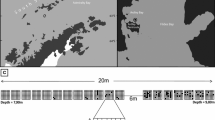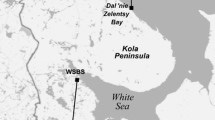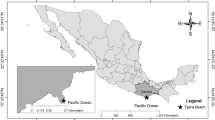Abstract
Four morphologically similar species in the sea anemone genus Epiactis exhibit overlapping distributions on the Pacific coast of North America; E. prolifera, E. lisbethae, E. ritteri and E. fernaldi. All brood their offspring up to the juvenile stage, but each has a different combination of internal versus external brooding and hermaphroditism versus gonochory (separate sexes). Specimens were collected from sites ranging from British Columbia to southern California between December 1988 and July 1992. Mating systems were inferred from genetic comparisons of mothers and offspring histological analyses of sex expression and observations on brooding and spawning behavior. Allozyme and multilocus DNA fingerprint analyses of the gynodioecious hermaphrodite E. prolifera showed that offspring were all identical to their mothers, a result consistent with either asexual reproduction, self-fertilization or extreme biparental inbreeding. In the gonochore E. lisbethae, mothers and offspring were also electrophoretically identical, but variation in DNA fingerprints indicated cross-fertilization. Similar DNA fingerprint differences between mother and offspring in the gonochore E. ritteri implied that cross-fertilization also occurs in this species. No mother-offspring comparisons were performed on E. fernaldi, as this species was not observed brooding offspring during this study. Although incomplete, the results of this study increase our knowledge of the very unusual combination of reproductive modes in the genus Epiactis, and argue for further investigations of the evolution and genetic consequences of mating systems in these species.
Similar content being viewed by others
References
Aebersold PB, Winans GA, Teel DJ, Milner GB, Utter FM (1987) Manual for starch gel electrophoresis: a method for the detection of genetic variation. NOAA natn mar Fish Serv tech Rep US Dep Commerce 61: 1–9
Ayala FJ, Hedgecock D, Zumwalt GS, Valentine JW (1973) Genetic variation in Tridacna maxima, an ecological analog of some unsuccessful evolutionary lineages. Evolution, Lawrence, Kansas 27: 177–191
Ayre DJ (1984) Effects of environment and population density on the sea anemone Actinia tenebrosa. Aust J mar Freshwat Res 35: 735–746
Ayre DJ (1988) Evidence for genetic determination of sex in Actinia tenebrosa. J exp mar Biol Ecol 116: 23–34
Black R, Johnson MS (1979) Asexual viviparity and population genetics of Actinia tenebrosa. Mar Biol 53: 27–31
Bucklin A, Hedgecock D, Hand C (1984) Genetic evidence of self-fertilization in the sea anemone Epiactis prolifera. Mar Biol 84: 175–182
Burke T (1989) DNA fingerprinting and other methods for the study of mating success. Trends Ecol Evol 4: 139–144
Burke T, Bruford MW (1987) DNA fingerprinting in birds. Nature, Lond 327: 149–152
Carter MA, Thorp CH (1979) The reproduction of Actinia equina var. mesembryanthemum. J mar biol Ass UK 59: 989–1001
Chia F-S (1976) Sea anemone reproduction: patterns and adaptive radiation. In: Mackie GO (ed) Coelenterate ecology and behavior. Plenum Press, New York, pp 261–270
Chia F-S, Rostron MA (1970) Some aspects of the reproductive biology of Actinia equina (Cnidaria: Anthozoa). J mar biol Ass UK 50: 253–264
Coffroth MA, Lasker HR, Diamond ME, Bruenn JA, Bermingham E (1992) DNA fingerprints of a gorgonian coral: a method for detecting clonal structure in vegetative species. Mar Biol 114: 317–325
Dunn DF (1972) The natural history of the sea anemone Epiactis prolifera Verrill, 1869, with special reference to its reproductive biology, Ph.D. dissertation. University of California, Berkeley
Dunn DF (1975a) Gynodioecy in an animal. Nature, Lond 253: 528–529
Dunn DF (1975b) Reproduction of the externally brooding sea anemone Epiactis prolifera Verrill, 1869. Biol Bull mar biol Lab, Woods Hole 148: 199–218
Dunn DF (1977a) Dynamics of external brooding in the sea anemone Epiactis prolifera. Mar Biol 39: 41–49
Dunn DF (1977b) Variability of Epiactis prolifera (Coelenterata: Actiniaria) in the intertidal zone near Bodega Bay, California, J nat Hist 11: 457–463
Edmands S (1994) Genetic and evolutionary consequences various reproductive strategies in the sea anemone genus Epiactis. Ph.D. dissertation. University of California, Santa Cruz
Ennos RA, Clegg MT (1982) Effects of population substructuring on estimates of outcrossing rate in plant populations. Heredity, Lond 48: 283–292
Fautin DG, Chia F-S (1986) Revision of the sea anemone genus Epiactis (Coelenterata: Actiniaria) on the Pacific coast of North America, with descriptions of two new brooding species. Can J Zool 64: 1665–1674
Franzen A (1970) Phylogenetic aspects of the morphology of spermatazoa and spermiogenesis. In: Bacetti B (ed) Comparative spermatology. Academic Press, New York, pp 29–46
Gashout SE, Ormond RFG (1979) Evidence for parthenogenetic reproduction in the sea anemone Actinia equina L. J mar biol Ass UK 59: 975–987
Hand C, Dunn DF (1974) Redescription and range extension of the sea anemone Cnidopus ritteri (Torrey) (Coelenterata: Actiniaria). Wasmann J Biol 32: 187–194
Harriot VJ (1983a) Reproductive ecology of four scleractinian species at Lizard Island, Great Barrier Reef. Coral Reefs 2: 9–18
Harriot VJ (1983b) Reproductive seasonality, settlement and post-settlement mortality of Pocillopora damicornis (Linnaeus), at Lizard Island, Great Barrier Reef. Coral Reefs 2: 151–157
Harris H, Hopkinson DA (1976) Handbook of electrophoresis in human genetics. American Elsevir, New York
Harrison PL (1985) Sexual characteristics of scleractinian corals: systematics and evolutionary implications. Proc 5th int coral Reef Congr 4: 337–342 [Gabrié C et al. (eds) Antenne Museum-EPHE, Moorea, French Polynesia]
Hoffmann RJ (1986) Variation in contributions of asexual reproduction to the genetic structure of populations of the sea anemone Metridium senile. Evolution, Lawrence, Kansas 42: 357–365
Humason GL (1967) Animal tissue techniques. W.H. Freeman, San Francisco
Jeffreys AJ, Morton DB (1987) DNA fingerprints of dogs and cats. Anim Genet 18: 1–15
Jeffreys AJ, Wilson V, Thein SL (1985a) Hypervariable ‘minisatellite’ regions in human DNA. Nature, Lond 314: 67–73
Jeffreys AJ, Wilson V, Thein SL (1985b) Individual-specific ‘fingerprints’ of human DNA. Nature, Lond 316: 76–79
Larkman AV, Carter MA (1980) The spermatozoon of Actinia equina L. var. mesembryanthemum. J mar biol Ass UK 60: 193–204
Levin DA (1978) Genetic variation in annual Phlox: self compatible versus self incompatible species. Evolution, Lawrence, Kansas 32: 245–263
Lewis D, Crowe LK (1955) The genetics and evolution of gynodioecy. Evolution, Lawrence, Kansas 10: 115–125
Lynch M (1990) The similarity index and DNA fingerprinting. Molec Biol Evolut 7: 478–484
Maniatis T, Fritsch EF, Sambrook J (1982) Molecular cloning: a laboratory manual. Cold Spring Harbor, New York
McGrath D, O'Foighil D (1986) Population dynamics and reproduction of hermaphroditic Lasaea rubra (Montagu), (Bivalvia: Galeommatacea). Ophelia 25: 209–219
Murphy RW, Sites JW Jr, Buth DG, Haufler CH (1990) In: Hillis DM, Moritz C (eds) Molecular systematics, Sinauer, Sunderland, Mass, pp 45–126
Orr J, Thorpe JP, Carter MA (1982) Biochemical genetic confirmation of the asexual reproduction of brooded offspring in the sea anemone Actinia equina. Mar Ecol Prog Ser 7: 227–229
Ottaway JR (1979) Population ecology of the intertidal anemone Actinia tenebrosa. II. Geographical distribution, synonomy, reproductive cycle and fecundity. Aust J Zool 27: 273–290
Ottaway JR, Kirby GC (1975) Genetic relationships between brooding and brooded Actinia tenebrosa. Nature, Lond 255: 221–223
Philander SG (1992) El Niño. Oceanus 35(2): 56–61
Rossi L (1975) Sexual races in Cereus pedunculatus (Boad.) Pubbl Staz zool Napoli (Suppl): 462–470
Shaklee JB, Allendorf FW, Morizot DC, Whitt GS (1990) Gene nomenclature for protein-coding loci in fish. Trans Am Fish Soc 119: 2–15
Shaw CR, Prasad R (1970) Starch gel electrophoresis of enzymes: a compilation of recipes. Biochem Genet 4: 297–320
Shick JM, Lamb AN (1977) Asexual reproduction and genetic population structure in the colonizing sea anemone Haliplanella luciae. Biol Bull mar biol Lab, Woods Hole 153: 604–617
Stoddart JA (1983) Asexual production of planulae in the coral Pocillopora damicornia. Mar Biol 76: 279–284
Stoddart JA, Black R (1985) Cycles of gametogenesis and planulation in the coral Pocillopora damicornis. Mar Ecol Prog Ser 23: 153–164
Tracey ML, Nelson K, Hedgecock D, Shleser RA, Pressick ML (1975) Biochemical genetics of lobsters: genetic variation and the structure of the American lobster (Homarus americanus) population. J Fish Res Bd Can 32: 2091–2101
Vassart G, Georges M, Monsieur R, Brocas H, Lequarre AS, Cristophe D (1987) A sequence in M13 phage detects hypervariable minisatellites in human and animal DNA. Science, NY 239: 683–684
Ward RD, Beardmore JA (1977) Protein variation in the plaice (Pleuronectes platissa). Genet Res 30: 45–62
Wetton JH, Carter RE, Parkin DT, Walters D (1987) Demographic study of a wild house sparrow population by DNA fingerprinting. Nature, Lond 327: 147–149
Author information
Authors and Affiliations
Additional information
Communicated by M.F. Strathmann, Friday Harbor
Rights and permissions
About this article
Cite this article
Edmands, S. Mating systems in the sea anemone genus Epiactis . Marine Biology 123, 723–733 (1995). https://doi.org/10.1007/BF00349115
Received:
Accepted:
Issue Date:
DOI: https://doi.org/10.1007/BF00349115




